Analysis of Spatiotemporal Predictions and Drivers of Carbon Storage in the Pearl River Delta Urban Agglomeration via the PLUS-InVEST-GeoDetector Model
Abstract
1. Introduction
2. Materials and Methods
2.1. Study Area
2.2. Methods
2.2.1. PLUS Model
2.2.2. InVEST Model
2.2.3. Scenario Setting
2.2.4. LUCC Accuracy Calibration and Verification
2.2.5. Geographical Detector Model
2.3. Data Sources
2.3.1. Remote Sensing Dataset of LUCC
2.3.2. Driving Factor Data
2.3.3. Carbon Density Data
3. Results
3.1. Spatiotemporal Analysis of Carbon Storage in the PRDUA from 2010 to 2020
3.1.1. Analysis of LUCC in the PRDUA from 2010 to 2020
3.1.2. Spatial and Temporal Evolution Characteristics of Land Use
3.1.3. Patterns in Carbon Storage Changes in the PRDUA from 2010 to 2020
3.2. Analysis of LUCC in the PRDUA under Multi-Scenario Simulations from 2020 to 2050
3.2.1. ND Scenario
3.2.2. CPD Scenario
3.2.3. EPD Scenario
3.3. Spatiotemporal Change of Carbon Storage in the PRDUA under Multi-Scenario Simulation
3.3.1. Temporal Change
3.3.2. Spatial Evolution
3.4. Driving Mechanisms of the Spatiotemporal Variability in LUCC and Carbon Storage
3.4.1. Driving Mechanisms of the LUCC in LEAS Module of the PLUS Model
3.4.2. Driving Mechanisms of the Change in Carbon Storage
4. Discussion
4.1. Response Relationship between Carbon Storage and Land Use Change
4.2. Characterization of Carbon Storage Dynamics under Different Scenario Simulations
4.3. Influence of Diverse Driving Factors on Carbon Storage
4.4. Research Limitation and Suggestions for Future Land Use Planning
5. Conclusions
- (1)
- From 2010 to 2020, agricultural and forest land in the PRDUA will decrease by 385.65 km2 and 547.22 km2, respectively, with the decrease accounting for 0.43% and 0.13% of their respective areas. Uncultivated land area will show the largest decrease (8.23%). Construction land area will increase sharply in both total area (952.64 km2) and magnitude (1.33%). Changes in land use will decrease carbon storage in the study area by 9.52 × 106 Mg in 10 years at a rate of 1.02%. The spatial distribution of carbon storage will generally increase from the central to peripheral areas.
- (2)
- LUCC in the PRDUA from 2020 to 2050 under the three scenarios showed obvious differences. Under the ND and CPD scenarios, agricultural land and forest land show the greatest decreases in area, while construction land showed the greatest increases. Under the EPD scenario, forest and construction land showed the greatest increases while agricultural land and grassland showed the greatest decreases. In the ND, CPD, and EPD scenarios, the land type with the largest area increase was construction land, with increases of 2011.16 km2, 2816.20 km2, and 100.04 km2, respectively, while the land types with the largest decrease were agriculture land, agricultural land, and grassland, with decreases of 1075.39 km2, 1445.63 km2, and 124.62 km2, respectively.
- (3)
- Changes in carbon storage in the PRDUA under the ND, CPD, and EPD scenarios were −25.82 × 106 Mg, −32.54 × 106 Mg, and +1.48 × 106 Mg, respectively, while the spatial distribution of carbon storage under the three scenarios showed similar clustering characteristics. High carbon storage values were mainly observed in the northeast, northwest, southwest, and city intersections, including Huizhou, Zhaoqing, and Jiangmen. Low carbon storage values were mainly located in the middle and southern areas, including Guangzhou, Shenzhen, Foshan, Dongguan, Zhuhai, and Zhongshan.
- (4)
- Distance to railway, population, GDP, DEM, and NDVI were the main drivers of the spatial differentiation of LUCC in the PRDUA. The contributions of natural environmental factors (e.g., NDVI and DEM) to changes in agricultural land, forest, grassland, water bodies, construction land, and unused land were 46.84%, 52.67%, 37.41%, 39.62%, 39.96%, and 42.4%, respectively. The interactions between the 15 drivers and changes in carbon storage were predominantly manifested as nonlinear enhancement and double-factor enhancement.
Author Contributions
Funding
Data Availability Statement
Conflicts of Interest
References
- Jeffry, L.; Ong, M.Y.; Nomanbhay, S.; Mofijur, M.; Mubashir, M.; Show, P.L. Greenhouse gases utilization: A review. Fuel 2021, 301, 121017. [Google Scholar] [CrossRef]
- Biermann, F.; Kanie, N.; Kim, R.E. Global governance by goal-setting: The novel approach of the UN Sustainable Development Goals. Curr. Opin. Environ. Sustain. 2017, 26, 26–31. [Google Scholar] [CrossRef]
- Li, J.; Guo, X.; Chuai, X.; Xie, F.; Yang, F.; Gao, R.; Ji, X. Reexamine China’s terrestrial ecosystem carbon balance under land use-type and climate change. Land Use Policy 2021, 102, 105275. [Google Scholar] [CrossRef]
- Wang, Y.; Quan, S.; Tang, X.; Hosono, T.; Hao, Y.; Tian, J.; Pang, Z. Organic and inorganic carbon sinks reduce long-term deep carbon emissions in the continental collision margin of the southern Tibetan Plateau: Implications for Cenozoic climate cooling. J. Geophys. Res. Solid Earth 2024, 129, e2024JB028802. [Google Scholar] [CrossRef]
- Qiu, S.; Yang, H.; Zhang, S.; Huang, S.; Zhao, S.; Xu, X.; He, P.; Zhou, W.; Zhao, Y.; Yan, N. Carbon storage in an arable soil combining field measurements, aggregate turnover modeling and climate scenarios. Catena 2023, 220, 106708. [Google Scholar] [CrossRef]
- Bai, X.; Zhang, S.; Smith, P.; Li, C.; Xiong, L.; Du, C.; Xue, Y.; Li, Z.; Long, M.; Li, M. Resolving controversies surrounding carbon sinks from carbonate weathering. Sci. China Earth Sci. 2024, 67, 2705–2717. [Google Scholar] [CrossRef]
- Sun, J.; Zhang, Y.; Qin, W.; Chai, G. Estimation and simulation of forest carbon stock in Northeast China forestry based on future climate change and LUCC. Remote Sens. 2022, 14, 3653. [Google Scholar] [CrossRef]
- Luo, K.; Wang, H.; Ma, C.; Wu, C.; Zheng, X.; Xie, L. Carbon sinks and carbon emissions balance of land use transition in Xinjiang, China: Differences and compensation. Sci. Rep. 2022, 12, 22456. [Google Scholar] [CrossRef]
- Wang, L.; Zhu, R.; Yin, Z.; Chen, Z.; Fang, C.; Lu, R.; Zhou, J.; Feng, Y. Impacts of land-use change on the spatio-temporal patterns of terrestrial ecosystem carbon storage in the Gansu Province, Northwest China. Remote Sens. 2022, 14, 3164. [Google Scholar] [CrossRef]
- Olalekan, M.R.; Ilesanmi, A.; Alima, O.; Omini, D.E. Exploring How Human Activities Disturb the Balance of Biogeochemical Cycles: Evidence from the Carbon, Nitrogen and Hydrologic Cycles. Res. World Agric. Econ. 2021, 2, 23–44. [Google Scholar] [CrossRef]
- Olorunfemi, I.E.; Olufayo, A.A.; Fasinmirin, J.T.; Komolafe, A.A. Dynamics of land use land cover and its impact on carbon stocks in Sub-Saharan Africa: An overview. Environ. Dev. Sustain. 2022, 24, 40–76. [Google Scholar] [CrossRef]
- Sharma, S.; MacKenzie, R.A.; Tieng, T.; Soben, K.; Tulyasuwan, N.; Resanond, A.; Blate, G.; Litton, C.M. The impacts of degradation, deforestation and restoration on mangrove ecosystem carbon stocks across Cambodia. Sci. Total Environ. 2020, 706, 135416. [Google Scholar] [CrossRef]
- Aitkenhead, M.; Coull, M. Mapping soil profile depth, bulk density and carbon stock in Scotland using remote sensing and spatial covariates. Eur. J. Soil Sci. 2020, 71, 553–567. [Google Scholar] [CrossRef]
- Sun, W.; Liu, X. Review on carbon storage estimation of forest ecosystem and applications in China. For. Ecosyst. 2020, 7, 1–14. [Google Scholar] [CrossRef]
- Piao, S.; He, Y.; Wang, X.; Chen, F. Estimation of China’s terrestrial ecosystem carbon sink: Methods, progress and prospects. Sci. China Earth Sci. 2022, 65, 641–651. [Google Scholar] [CrossRef]
- Tian, L.; Wu, X.; Tao, Y.; Li, M.; Qian, C.; Liao, L.; Fu, W. Review of remote sensing-based methods for forest aboveground biomass estimation: Progress, challenges, and prospects. Forests 2023, 14, 1086. [Google Scholar] [CrossRef]
- Wang, R.-Y.; Mo, X.; Ji, H.; Zhu, Z.; Wang, Y.-S.; Bao, Z.; Li, T. Comparison of the CASA and InVEST models’ effects for estimating spatiotemporal differences in carbon storage of green spaces in megacities. Sci. Rep. 2024, 14, 5456. [Google Scholar] [CrossRef] [PubMed]
- Hu, Y.; Li, Y.; Zhang, H.; Liu, X.; Zheng, Y.; Gong, H. The trajectory of carbon emissions and terrestrial carbon sinks at the provincial level in China. Sci. Rep. 2024, 14, 5828. [Google Scholar] [CrossRef]
- Kafy, A.-A.; Saha, M.; Fattah, M.A.; Rahman, M.T.; Duti, B.M.; Rahaman, Z.A.; Bakshi, A.; Kalaivani, S.; Rahaman, S.N.; Sattar, G.S. Integrating forest cover change and carbon storage dynamics: Leveraging Google Earth Engine and InVEST model to inform conservation in hilly regions. Ecol. Indic. 2023, 152, 110374. [Google Scholar] [CrossRef]
- Tian, L.; Tao, Y.; Fu, W.; Li, T.; Ren, F.; Li, M. Dynamic simulation of land use/cover change and assessment of forest ecosystem carbon storage under climate change scenarios in Guangdong Province, China. Remote Sens. 2022, 14, 2330. [Google Scholar] [CrossRef]
- Wang, Z.; Zeng, J.; Chen, W. Impact of urban expansion on carbon storage under multi-scenario simulations in Wuhan, China. Environ. Sci. Pollut. Res. 2022, 29, 45507–45526. [Google Scholar] [CrossRef] [PubMed]
- Deng, Y.; Yao, S.; Hou, M.; Zhang, T.; Lu, Y.; Gong, Z.; Wang, Y. Assessing the effects of the Green for Grain Program on ecosystem carbon storage service by linking the InVEST and FLUS models: A case study of Zichang county in hilly and gully region of Loess Plateau. J. Nat. Resour. 2020, 35, 826–844. [Google Scholar] [CrossRef]
- Tang, L.; Ke, X.; Zhou, Q.; Wang, L.; Koomen, E. Projecting future impacts of cropland reclamation policies on carbon storage. Ecol. Indic. 2020, 119, 106835. [Google Scholar] [CrossRef]
- Shaffer, J.A.; Roth, C.L.; Mushet, D.M. Modeling effects of crop production, energy development and conservation-grassland loss on avian habitat. PLoS ONE 2019, 14, e0198382. [Google Scholar] [CrossRef]
- Li, M.; Liang, D.; Xia, J.; Song, J.; Cheng, D.; Wu, J.; Cao, Y.; Sun, H.; Li, Q. Evaluation of water conservation function of Danjiang River Basin in Qinling Mountains, China based on InVEST model. J. Environ. Manag. 2021, 286, 112212. [Google Scholar] [CrossRef]
- Hu, W.; Li, G.; Gao, Z.; Jia, G.; Wang, Z.; Li, Y. Assessment of the impact of the Poplar Ecological Retreat Project on water conservation in the Dongting Lake wetland region using the InVEST model. Sci. Total Environ. 2020, 733, 139423. [Google Scholar] [CrossRef] [PubMed]
- Zhang, Z.; Hu, B.; Jiang, W.; Qiu, H. Identification and scenario prediction of degree of wetland damage in Guangxi based on the CA-Markov model. Ecol. Indic. 2021, 127, 107764. [Google Scholar] [CrossRef]
- Liang, X.; Liu, X.; Li, X.; Chen, Y.; Tian, H.; Yao, Y. Delineating multi-scenario urban growth boundaries with a CA-based FLUS model and morphological method. Landsc. Urban Plan. 2018, 177, 47–63. [Google Scholar] [CrossRef]
- Huang, D.; Huang, J.; Liu, T. Delimiting urban growth boundaries using the CLUE-S model with village administrative boundaries. Land Use Policy 2019, 82, 422–435. [Google Scholar] [CrossRef]
- Liang, X.; Guan, Q.; Clarke, K.C.; Liu, S.; Wang, B.; Yao, Y. Understanding the drivers of sustainable land expansion using a patch-generating land use simulation (PLUS) model: A case study in Wuhan, China. Comput. Environ. Urban Syst. 2021, 85, 101569. [Google Scholar] [CrossRef]
- Guo, W.; Teng, Y.; Li, J.; Yan, Y.; Zhao, C.; Li, Y.; Li, X. A new assessment framework to forecast land use and carbon storage under different SSP-RCP scenarios in China. Sci. Total Environ. 2024, 912, 169088. [Google Scholar] [CrossRef] [PubMed]
- Wei, Q.; Abudureheman, M.; Halike, A.; Yao, K.; Yao, L.; Tang, H.; Tuheti, B. Temporal and spatial variation analysis of habitat quality on the PLUS-InVEST model for Ebinur Lake Basin, China. Ecol. Indic. 2022, 145, 109632. [Google Scholar] [CrossRef]
- Wu, X.; Huang, Y.; Gao, J. Impact of industrial agglomeration on new-type urbanization: Evidence from Pearl River Delta urban agglomeration of China. Int. Rev. Econ. Financ. 2022, 77, 312–325. [Google Scholar] [CrossRef]
- Du, S.; Zhou, Z.; Huang, D.; Zhang, F.; Deng, F.; Yang, Y. The Response of Carbon Stocks to Land Use/Cover Change and a Vulnerability Multi-Scenario Analysis of the Karst Region in Southern China Based on PLUS-InVEST. Forests 2023, 14, 2307. [Google Scholar] [CrossRef]
- Li, M.; Gao, Q.; Yu, T. Using appropriate Kappa statistic in evaluating inter-rater reliability. Short communication on “Groundwater vulnerability and contamination risk mapping of semi-arid Totko river basin, India using GIS-based DRASTIC model and AHP techniques”. Chemosphere 2023, 328, 138565. [Google Scholar] [CrossRef] [PubMed]
- Zhang, T.; Song, B.; Han, G.; Zhao, H.; Hu, Q.; Zhao, Y.; Liu, H. Effects of coastal wetland reclamation on soil organic carbon, total nitrogen, and total phosphorus in China: A meta-analysis. Land Degrad. Dev. 2023, 34, 3340–3349. [Google Scholar] [CrossRef]
- Wang, R.-Y.; Cai, H.; Chen, L.; Li, T. Spatiotemporal Evolution and Multi-Scenario Prediction of Carbon Storage in the GBA Based on PLUS–InVEST Models. Sustainability 2023, 15, 8421. [Google Scholar] [CrossRef]
- Zhang, Y.; Naerkezi, N.; Zhang, Y.; Wang, B. Multi-Scenario Land Use/Cover Change and Its Impact on Carbon Storage Based on the Coupled GMOP-PLUS-InVEST Model in the Hexi Corridor, China. Sustainability 2024, 16, 1402. [Google Scholar] [CrossRef]
- Yang, C.; Liu, H.; Li, Q.; Cui, A.; Xia, R.; Shi, T.; Zhang, J.; Gao, W.; Zhou, X.; Wu, G. Rapid urbanization induced extensive forest loss to urban land in the Guangdong-Hong Kong-Macao Greater Bay Area, China. Chin. Geogr. Sci. 2021, 31, 93–108. [Google Scholar] [CrossRef]
- Wang, R.; Zhao, J.; Chen, G.; Lin, Y.; Yang, A.; Cheng, J. Coupling PLUS–InVEST model for ecosystem service research in Yunnan Province, China. Sustainability 2022, 15, 271. [Google Scholar] [CrossRef]
- Liu, K.; Zhang, C.; Zhang, H.; Xu, H.; Xia, W. Spatiotemporal Variation and Dynamic Simulation of Ecosystem Carbon Storage in the Loess Plateau Based on PLUS and InVEST Models. Land 2023, 12, 1065. [Google Scholar] [CrossRef]
- Li, P.; Chen, J.; Li, Y.; Wu, W. Using the InVEST-PLUS model to predict and analyze the pattern of ecosystem carbon storage in Liaoning Province, China. Remote Sens. 2023, 15, 4050. [Google Scholar] [CrossRef]
- Xu, A.; Song, M.; Wu, Y.; Luo, Y.; Zhu, Y.; Qiu, K. Effects of new urbanization on China’s carbon emissions: A quasi-natural experiment based on the improved PSM-DID model. Technol. Forecast. Soc. Chang. 2024, 200, 123164. [Google Scholar] [CrossRef]


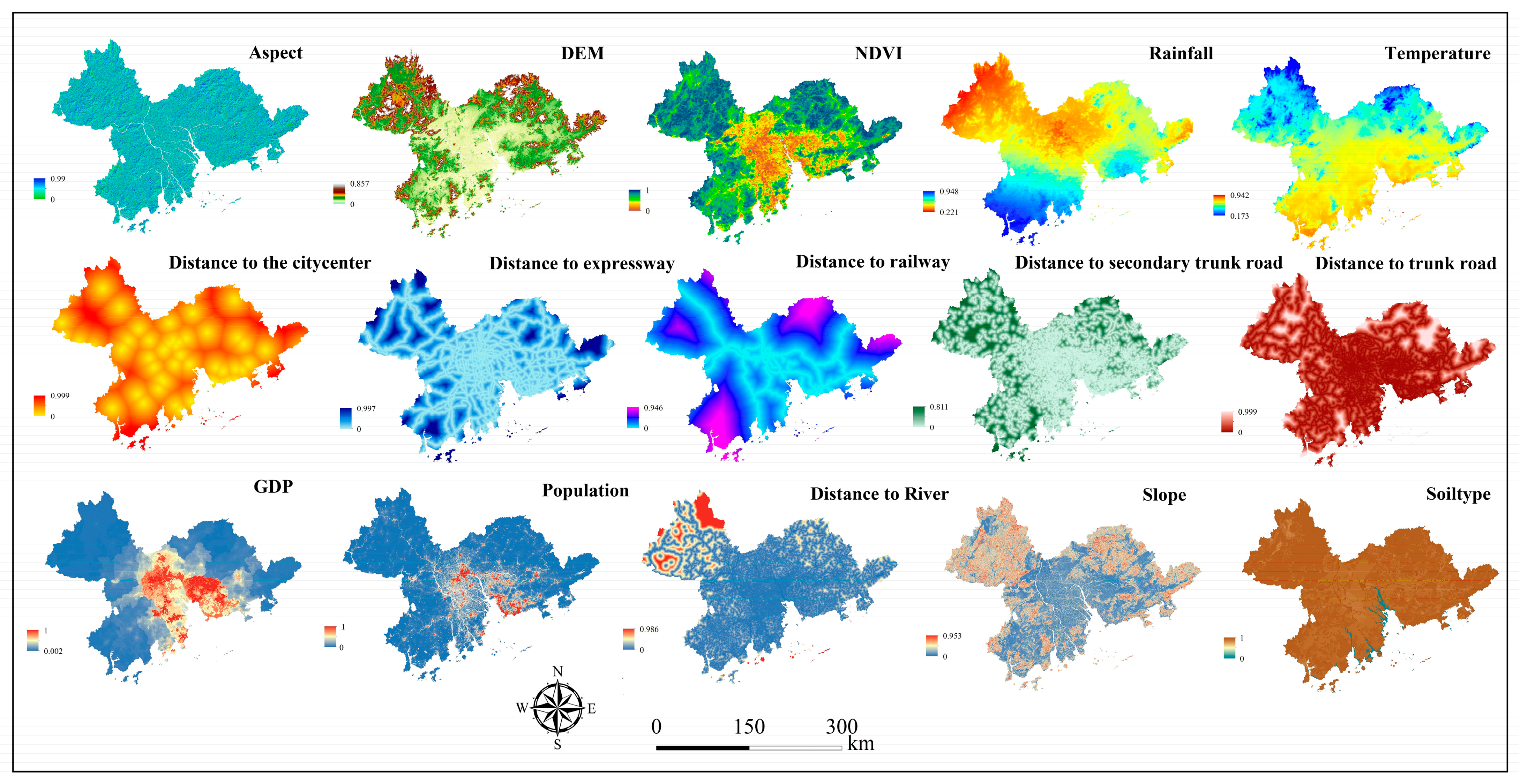



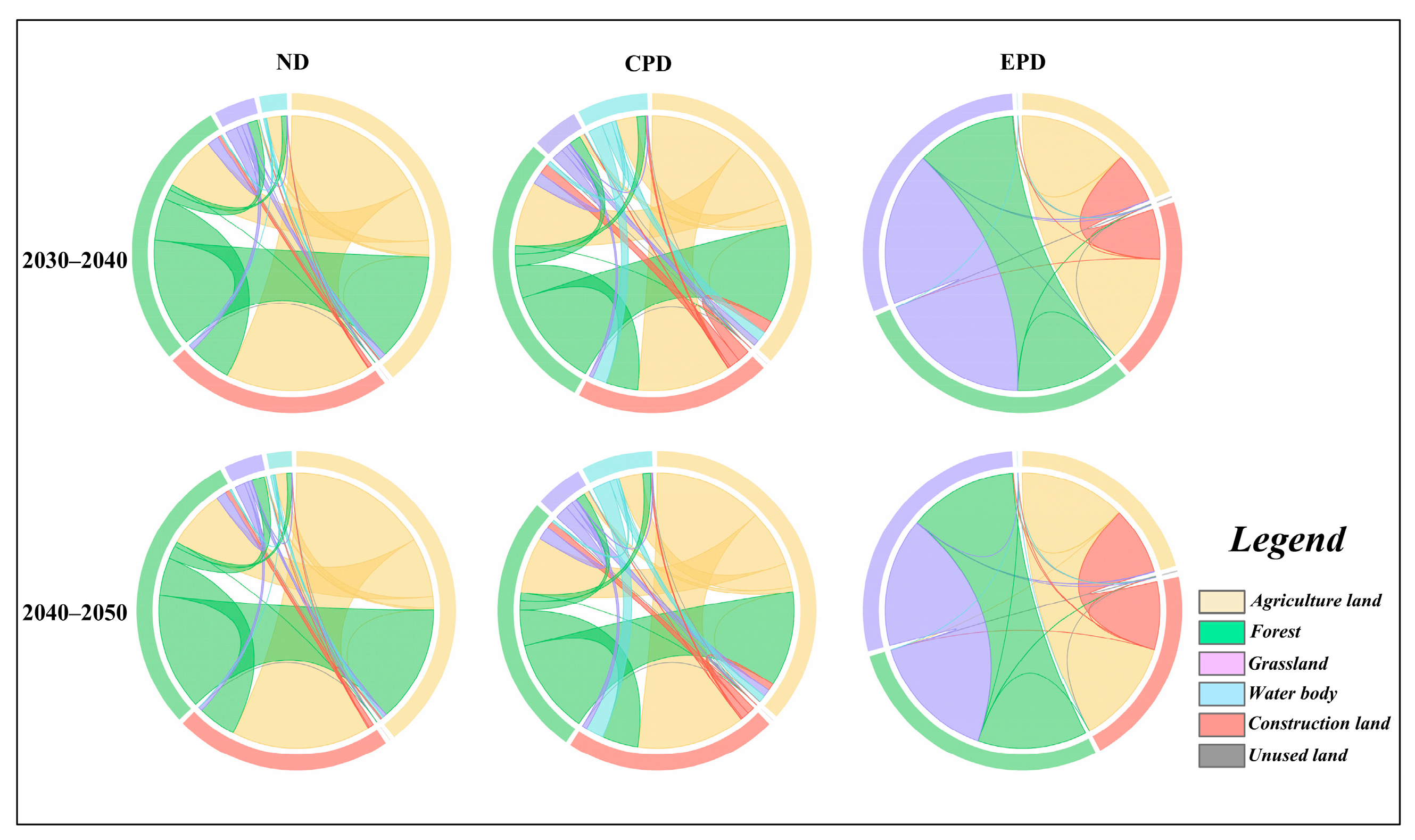
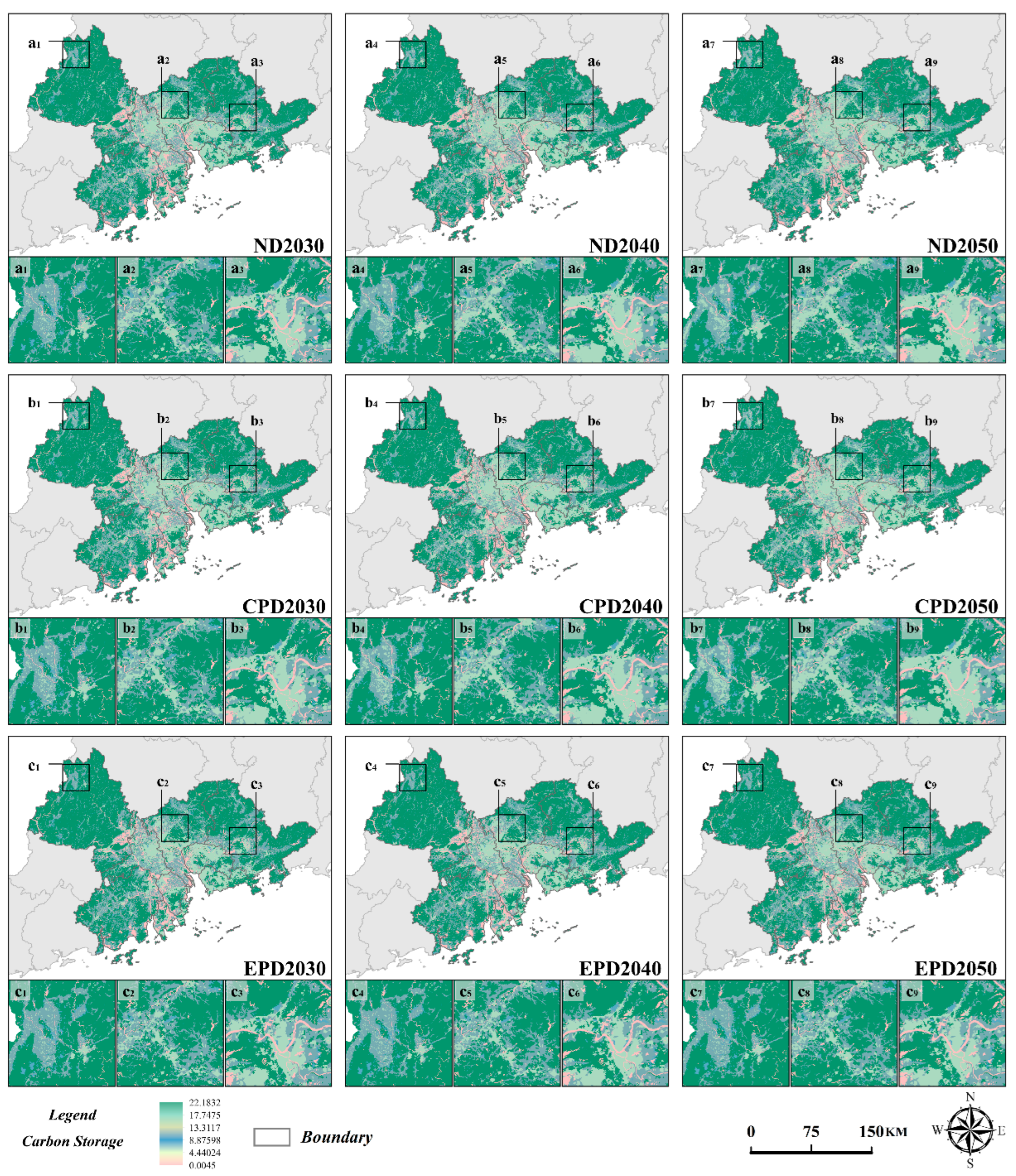

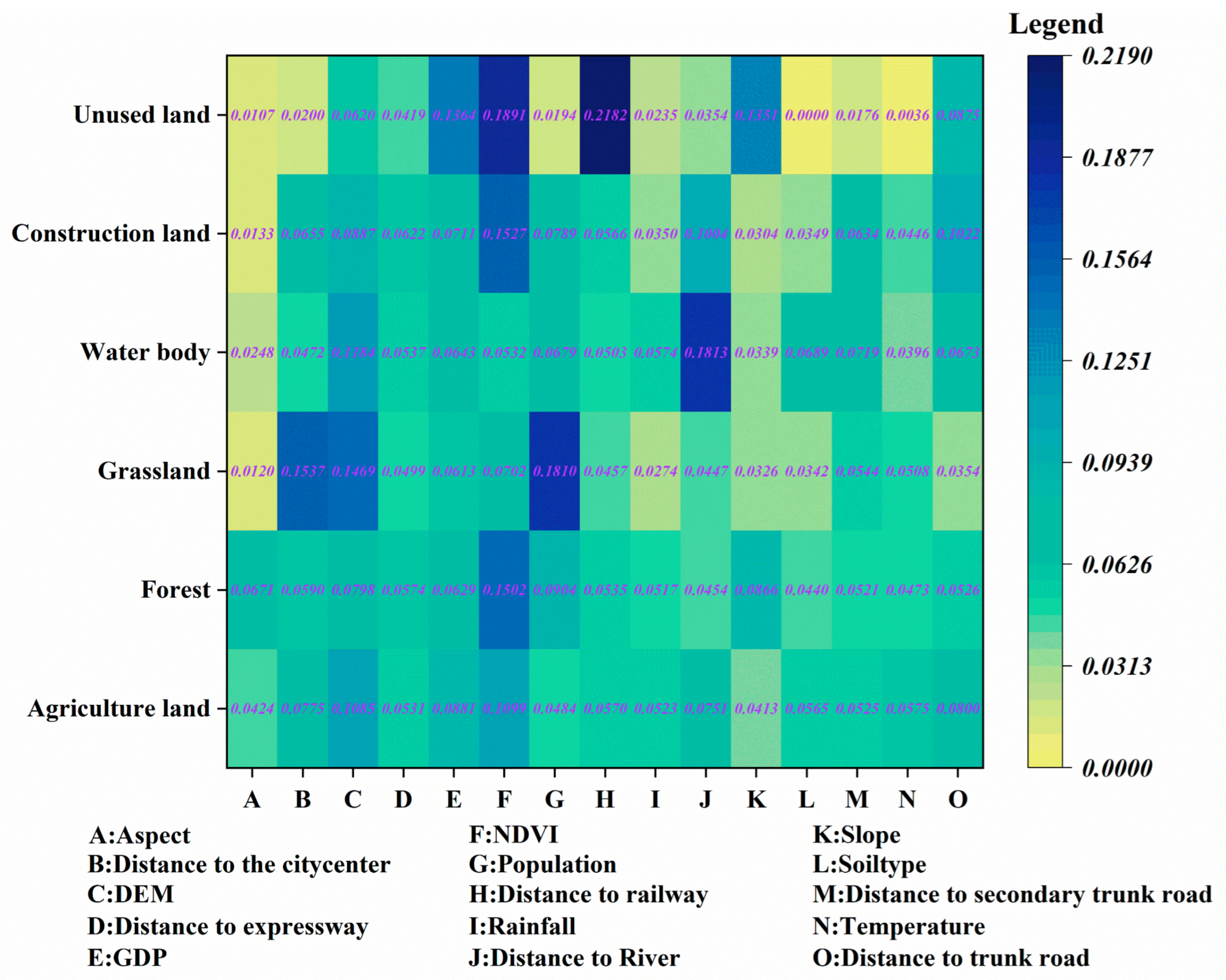
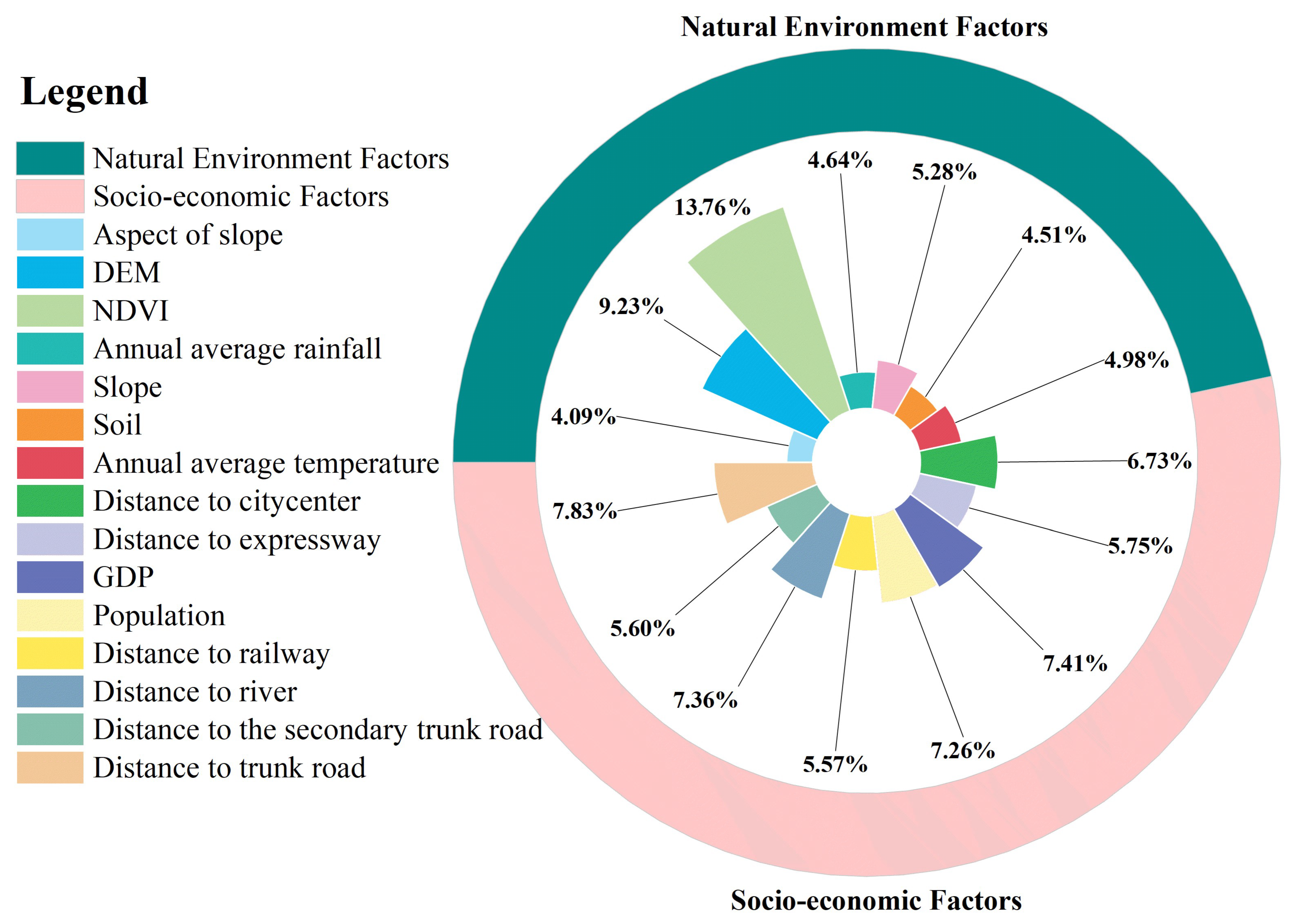

| Scenario | Principles Underlying Scenario Setting |
|---|---|
| ND | Based on OD2010 and OD2020, the PLUS model summarizes and perpetuates the pattern of change, and scenarios are simulated based on continuous economic development and urbanization to obtain scenarios of natural development without the intervention of special policies (e.g., certain land must be developed under policy conditions). |
| CPD | In this scenario, urban development is the main focus, with reference to the objective of ‘Accelerating the establishment of the Great Bay Area on the railway and driving the synergistic development of the Guangzhou Metropolitan Area, Shenzhen Metropolitan Area, and the Zhuhai-Zhongjiang Region’ in the land space planning of Guangdong Province (2021–2035). Moreover, it also considers the land use development plan of the towns in the study area and allows for the conversion of water bodies to construction land. The conversion of water bodies to construction land is allowed, meaning that lake filling or reclamation is allowed for construction. The probability of conversion of other land to construction land is increased by 20%. |
| EPD | In this scenario, the objective is ‘building a low-carbon, ecological, high-efficiency and high-quality urban and rural planning and construction model, and optimizing the spatial pattern of the urban and rural areas’ in the integrated urban and rural planning plan for the Pearl River Delta (2009–2020). This scenario includes implementing stringent protection measures for key ecological areas, increasing the area of forests, reducing the rate of reduction in the area of grassland, and limiting the rapid expansion of built-up land. Nature reserves have been added as restricted construction areas; the probability of the conversion of forest and grassland to construction land has been reduced by 30%; the probability of conversion of agricultural land to construction land has been reduced by 50%; and water bodies may not be converted to other land, although other land is allowed to be converted to water bodies. |
| Land Use Type | ND | CPD | EPD | |||||||||||||||
|---|---|---|---|---|---|---|---|---|---|---|---|---|---|---|---|---|---|---|
| a | b | c | d | e | f | a | b | c | d | e | f | a | b | c | d | e | f | |
| a | 1 | 1 | 1 | 1 | 1 | 0 | 1 | 1 | 1 | 1 | 1 | 0 | 1 | 1 | 1 | 1 | 1 | 0 |
| b | 1 | 1 | 1 | 1 | 1 | 0 | 1 | 1 | 1 | 1 | 1 | 0 | 0 | 1 | 1 | 0 | 0 | 0 |
| c | 1 | 1 | 1 | 1 | 1 | 0 | 1 | 1 | 1 | 1 | 1 | 0 | 0 | 1 | 1 | 0 | 0 | 0 |
| d | 0 | 0 | 0 | 1 | 0 | 0 | 0 | 0 | 0 | 1 | 1 | 0 | 0 | 0 | 0 | 1 | 0 | 0 |
| e | 0 | 0 | 0 | 0 | 1 | 0 | 0 | 0 | 0 | 0 | 1 | 0 | 0 | 0 | 0 | 0 | 1 | 0 |
| f | 1 | 1 | 1 | 1 | 1 | 1 | 1 | 1 | 1 | 1 | 1 | 1 | 1 | 1 | 1 | 1 | 1 | 1 |
| Land Use Type | Agriculture Land | Forest | Grassland | Water Body | Construction Land | Unused Land | |
|---|---|---|---|---|---|---|---|
| Scenario | |||||||
| ND | 0.2248 | 0.1636 | 0.0498 | 0.1236 | 0.4379 | 0.0002 | |
| CPD | 0.1124 | 0.0818 | 0.0249 | 0.0618 | 0.8758 | 0.0001 | |
| EPD | 0.2248 | 0.3273 | 0.0997 | 0.1236 | 0.4379 | 0.0002 | |
| Category | Data | Data Resource | Original Resolution (m) |
|---|---|---|---|
| Socioeconomic Factors | Population | Open Spatial Demographic Data and Research (https://www.worldpop.org/, accessed on 5 April 2023) | 100 |
| GDP | Global Change Research Data Publishing and Repository (http://www.geodoi.ac.cn, accessed on 6 April 2023) | 1000 | |
| Distance to railway | OpenStreetMap (https://www.openstreetmap.org/, accessed on 10 April 2023) | 90 | |
| Distance to expressway | |||
| Distance to trunk road | |||
| Distance to the secondary trunk road | |||
| Distance to the city center | |||
| Distance to river | |||
| Natural Environmental Factors | Soil | National Qinghai–Tibet Plateau Scientific Data Center (http://data.tpdc.ac.cn/, accessed on 13 April 2023) | 1000 |
| NDVI | Earthdata Search (https://search.earthdata.nasa.gov/search, accessed on 20 April 2023) | 250 | |
| Annual average temperature | WorldClim (https://worldclim.org/data/index.html, accessed on 11 April 2023) | 490 | |
| Annual average rainfall | |||
| DEM | Geospatial Data Cloud (http://www.gscloud.cn, accessed on 6 April 2023) | 30 | |
| Slope | |||
| Aspect of slope |
| Land Use Type | Aboveground | Belowground | Soil Organic | Dead Organic Matter | Total |
|---|---|---|---|---|---|
| Agriculture land | 31.32 | 2.16 | 86.17 | 1.17 | 120.82 |
| Forest | 49.25 | 17.92 | 171.7 | 7.61 | 246.48 |
| Grassland | 2.38 | 11.23 | 68.08 | 2.22 | 83.91 |
| Water body | 0.05 | 0 | 0 | 0 | 0.05 |
| Construction land | 0.26 | 2.01 | 61.78 | 0 | 64.05 |
| Unused land | 0.43 | 0 | 62.87 | 0 | 63.3 |
| Land Use Type | 2010 | 2020 | 2010–2020 | K * |
|---|---|---|---|---|
| Agriculture land | 12,596.73 | 12,049.51 | −547.22 | −0.43% |
| Forest | 29,428.98 | 29,043.33 | −385.65 | −0.13% |
| Grassland | 949.3434 | 1031.603 | 82.26 | 0.87% |
| Water body | 4046.033 | 3975.3774 | −70.66 | −0.18% |
| Construction land | 7137.203 | 8089.844 | 952.64 | 1.33% |
| Unused land | 38.1159 | 6.7446 | −31.37 | −8.23% |
| Period | Agriculture Land | Forest | Grassland | Water Body | Construction Land | Unused Land | |
|---|---|---|---|---|---|---|---|
| OD | 2020 | 12,049.51 | 29,043.33 | 1031.60 | 3975.38 | 8089.84 | 6.74 |
| ND | 2030 | 11,609.30 | 28,684.91 | 960.25 | 4060.40 | 8876.30 | 5.24 |
| 2040 | 11,256.08 | 28,351.34 | 922.73 | 4122.51 | 9539.11 | 4.63 | |
| 2050 | 10,974.11 | 28,040.73 | 914.01 | 4162.28 | 10,101.01 | 4.26 | |
| 2020–2030 | −440.21 | 358.42 | −71.35 | 85.03 | 786.46 | −1.5 | |
| 2030–2040 | −353.21 | −333.57 | −37.52 | 62.11 | 662.81 | −0.61 | |
| 2040–2050 | −281.97 | −310.6 | −8.72 | 39.77 | 561.89 | −0.37 | |
| CPD | 2030 | 11,448.75 | 28,587.06 | 924.04 | 4028.73 | 9204.03 | 3.78 |
| 2040 | 10,975.14 | 28,163.65 | 857.09 | 4067.05 | 10,130.58 | 2.88 | |
| 2050 | 10,603.87 | 27,770.5 | 827.74 | 4085.79 | 10,906.05 | 2.46 | |
| 2020–2030 | −600.75 | −456.27 | −107.57 | 53.36 | 1114.19 | −2.96 | |
| 2030–2040 | −473.61 | −423.41 | −66.94 | 38.32 | 926.55 | −0.9 | |
| 2040–2050 | −371.27 | −393.15 | −29.36 | 18.74 | 775.47 | −0.42 | |
| EPD | 2030 | 12,003.69 | 29,127.25 | 948.55 | 3975.60 | 8135.76 | 5.56 |
| 2040 | 11,971.08 | 29,157.46 | 918.54 | 3975.60 | 8168.20 | 5.52 | |
| 2050 | 11,949.24 | 29,169.13 | 906.98 | 3975.63 | 8189.88 | 5.54 | |
| 2020–2030 | −45.81 | 83.92 | −83.05 | 0.22 | 45.92 | −1.19 | |
| 2030–2040 | −32.61 | 30.2148 | −30.01 | 0.01 | 32.44 | −0.04 | |
| 2040–2050 | −21.84 | 11.67 | −11.56 | 0.03 | 21.68 | 0.01 | |
| Period | Agriculture Land (Rate%) | Forest (Rate%) | Grassland (Rate%) | Water Body (Rate%) | Construction Land (Rate%) | Unused Land (Rate%) | Total | |
|---|---|---|---|---|---|---|---|---|
| OD | 2010 | 152.19 (16.34%) | 725.37 (77.87%) | 7.97 (0.86%) | 0.0202 (0.0022%) | 45.71 (4.91%) | 0.2413 (0.0259%) | 931.50 |
| 2020 | 145.58 (15.79%) | 715.86 (77.64%) | 8.66 (0.94%) | 0.0199 (0.0022%) | 51.82 (5.62%) | 0.0427 (0.0046%) | 921.98 | |
| ND | 2030 | 140.26 (15.38%) | 707.03 (77.50%) | 8.06 (0.88%) | 0.0203 (0.0022%) | 56.85 (6.23%) | 0.0332 (0.0036%) | 912.25 |
| 2040 | 136.00 (15.05%) | 698.80 (77.33%) | 7.74 (0.86%) | 0.0206 (0.0023%) | 61.10 (6.76%) | 0.0293 (0.0032%) | 903.69 | |
| 2050 | 132.59 (14.80%) | 691.15 (77.12%) | 7.67 (0.86%) | 0.0208 (0.0023%) | 64.70 (7.22%) | 0.0270 (0.0030%) | 896.15 | |
| CPD | 2030 | 138.32 (15.21%) | 704.61 (77.46%) | 7.75 (0.85%) | 0.0201 (0.0022%) | 58.95 (6.48%) | 0.0240 (0.0026%) | 909.69 |
| 2040 | 132.60 (14.75%) | 694.18 (77.23%) | 7.19 (0.80%) | 0.0203 (0.0023%) | 64.89 (7.22%) | 0.0183 (0.0020%) | 898.90 | |
| 2050 | 128.12 (14.40%) | 684.49 (76.96%) | 6.95 (0.78%) | 0.0204 (0.0023%) | 69.85 (7.85%) | 0.0156 (0.0018%) | 889.44 | |
| EPD | 2030 | 145.03 (15.71%) | 717.93 (77.78%) | 7.96 (0.86%) | 0.0199 (0.0022%) | 52.11 (5.65%) | 0.0352 (0.0038%) | 923.08 |
| 2040 | 144.63 (15.66%) | 718.67 (77.83%) | 7.71 (0.83%) | 0.0199 (0.0022%) | 52.32 (5.67%) | 0.0350 (0.0038%) | 923.39 | |
| 2050 | 144.37 (15.63%) | 718.96 (77.86%) | 7.61 (0.82%) | 0.0199 (0.0022%) | 52.46 (5.68%) | 0.0350 (0.0038%) | 923.45 | |
| Category | Driving Factors | q-Value |
|---|---|---|
| Natural Environment Factors | Soil | 0.0954 |
| Slope | 0.0340 | |
| DEM | 0.1385 | |
| NDVI | 0.0625 | |
| Aspect of slope | 0.0003 | |
| Annual average rainfall | 0.5383 | |
| Annual average temperature | 0.5559 | |
| Socioeconomic Factors | GDP | 0.1661 |
| Population | 0.0500 | |
| Distance to river | 0.0984 | |
| Distance to railway | 0.0184 | |
| Distance to city center | 0.0401 | |
| Distance to trunk road | 0.0509 | |
| Distance to expressway | 0.0133 | |
| Distance to the secondary trunk road | 0.0110 |
Disclaimer/Publisher’s Note: The statements, opinions and data contained in all publications are solely those of the individual author(s) and contributor(s) and not of MDPI and/or the editor(s). MDPI and/or the editor(s) disclaim responsibility for any injury to people or property resulting from any ideas, methods, instructions or products referred to in the content. |
© 2024 by the authors. Licensee MDPI, Basel, Switzerland. This article is an open access article distributed under the terms and conditions of the Creative Commons Attribution (CC BY) license (https://creativecommons.org/licenses/by/4.0/).
Share and Cite
Cai, J.; Chi, H.; Lu, N.; Bian, J.; Chen, H.; Yu, J.; Yang, S. Analysis of Spatiotemporal Predictions and Drivers of Carbon Storage in the Pearl River Delta Urban Agglomeration via the PLUS-InVEST-GeoDetector Model. Energies 2024, 17, 5093. https://doi.org/10.3390/en17205093
Cai J, Chi H, Lu N, Bian J, Chen H, Yu J, Yang S. Analysis of Spatiotemporal Predictions and Drivers of Carbon Storage in the Pearl River Delta Urban Agglomeration via the PLUS-InVEST-GeoDetector Model. Energies. 2024; 17(20):5093. https://doi.org/10.3390/en17205093
Chicago/Turabian StyleCai, Jinghang, Hui Chi, Nan Lu, Jin Bian, Hanqing Chen, Junkeng Yu, and Suqin Yang. 2024. "Analysis of Spatiotemporal Predictions and Drivers of Carbon Storage in the Pearl River Delta Urban Agglomeration via the PLUS-InVEST-GeoDetector Model" Energies 17, no. 20: 5093. https://doi.org/10.3390/en17205093
APA StyleCai, J., Chi, H., Lu, N., Bian, J., Chen, H., Yu, J., & Yang, S. (2024). Analysis of Spatiotemporal Predictions and Drivers of Carbon Storage in the Pearl River Delta Urban Agglomeration via the PLUS-InVEST-GeoDetector Model. Energies, 17(20), 5093. https://doi.org/10.3390/en17205093






